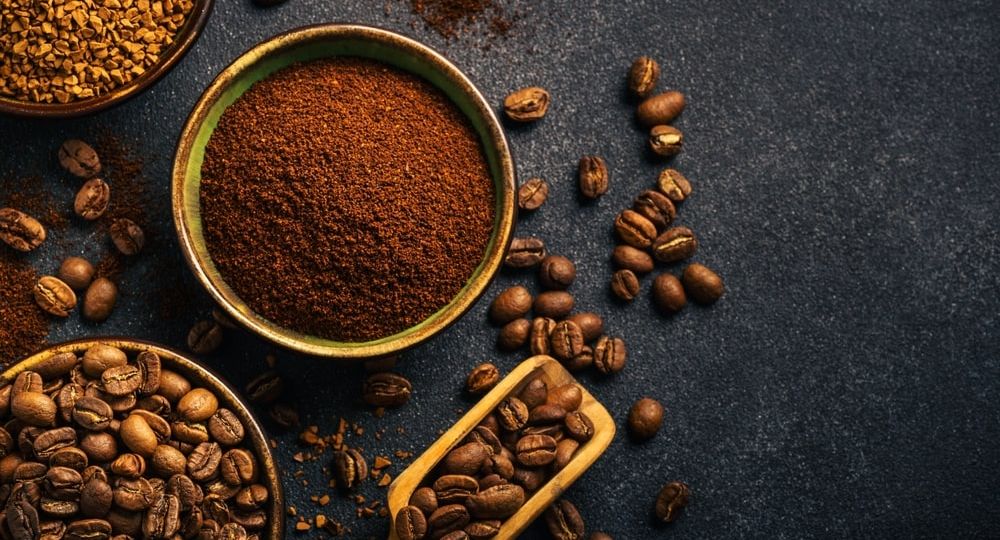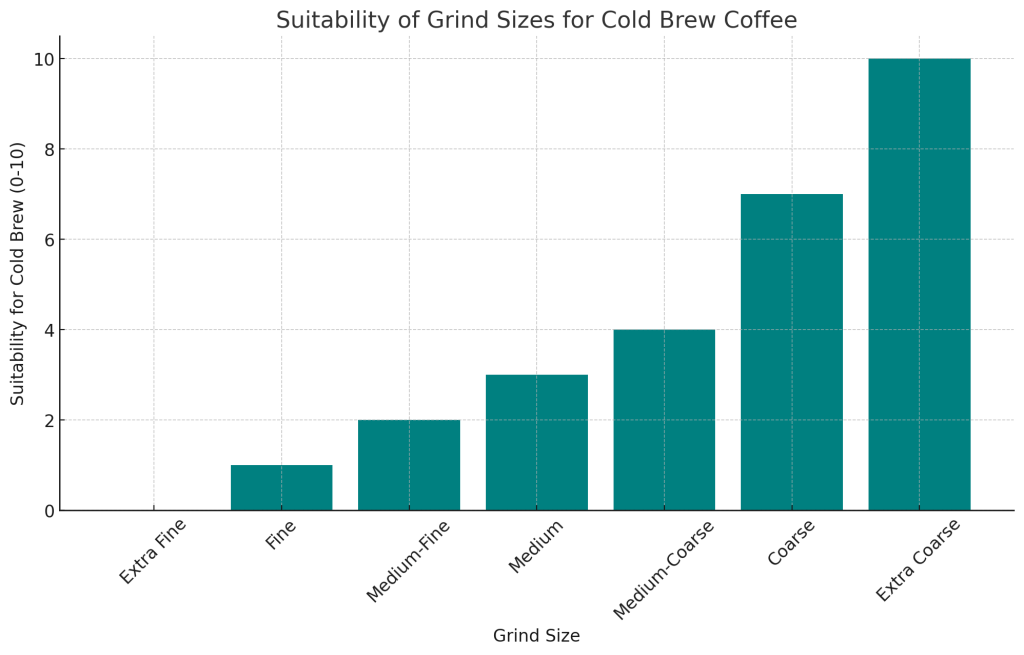
Cold brew coffee, a beloved beverage for many, stands out for its smooth, rich flavor profile, distinguished significantly from its hot brewed counterpart. This brewing method involves steeping coarsely ground coffee beans in cold water for an extended period, typically 12 to 24 hours.
The result? A concentrate that’s less acidic, more nuanced, and can be enjoyed straight from the fridge on those warm days or as a base for various coffee drinks. The perfect cold brew experience lies in the grind size, with the extra coarse grind coming out on top. This size prevents over-extraction, a common pitfall that leads to bitterness, ensuring each sip is as smooth as it is flavorful.
Key Takeaways
- Extra Coarse Grind Size: When it comes to cold brew, the coarser, the better. An extra coarse grind size is essential to avoid over-extraction and bitterness, letting the natural, milder flavors of the coffee shine through. This grind size ensures that the water can flow freely around the coffee particles, extracting the flavors gradually and effectively.
- Burr Grinders: Achieving the perfect extra coarse grind is no small feat, which is why burr grinders are the tool for the job. Unlike blade grinders, which chop beans inconsistently, burr grinders crush beans to a uniform size. This consistency is crucial for cold brew, ensuring every batch is just as delicious as the last.
- Coffee Bean Origin, Roast Level, and Freshness: The taste of your cold brew is also influenced by the origin and roast level of your beans. Darker roasts lend a bold, straightforward flavor well-suited to cold brewing, while the freshness of your beans is paramount. Freshly ground beans retain their oils and aromas, enriching the brew with complex flavors and scents.

This chart visualizes the suitability of different grind sizes for making cold brew coffee, rated on a scale from 0 to 10, where 0 indicates not suitable at all and 10 signifies the most suitable. Starting from the left, we have the finest grinds, moving towards the coarser grinds on the right.
- Extra Fine: Rated 0, indicating it’s not suitable for cold brew. Extra fine grind is much too small, leading to over-extraction and bitterness in a cold brew setup.
- Fine: With a rating of 1, fine grind is slightly more suitable than extra fine but still largely inappropriate for cold brew due to similar over-extraction issues.
- Medium-Fine: Scored at 2, it’s slightly better than fine but still not ideal for cold brew, as it doesn’t allow for the optimal slow extraction desired.
- Medium: Given a rating of 3, medium grind size is still not ideal for cold brew. While better than finer grinds, it may still lead to over-extraction and a bitter taste.
- Medium-Coarse: Scored at 4, indicating it’s somewhat suitable but still not optimal. This grind size starts to approach the coarseness needed but may not extract flavors as efficiently as coarser grinds.
- Coarse: With a rating of 7, coarse grind is suitable for cold brew, offering a better balance that allows water to extract coffee flavors slowly and evenly without over-extraction.
- Extra Coarse: Rated the highest at 10, this grind size is the most suitable for cold brew. It ensures a slow and even extraction, capturing the coffee’s full flavor profile without bitterness, making it the ideal choice for cold brew coffee.
The chart effectively communicates that as the grind size increases (from left to right), its suitability for cold brew coffee also increases, with extra coarse grind emerging as the clear winner for this brewing method.
Understanding Grind Sizes
Grind size in coffee brewing is akin to selecting the right tool for a job—it can make or break the end result. From fine to extra coarse, each grind size opens up a different avenue of flavor and strength. Imagine fine grind as powdery as flour, suitable for espresso where water and coffee are in contact for mere seconds.
Moving up the scale, medium grinds resemble sand, perfect for drip coffee makers where water filters through a bit slower. Then comes the coarse grind, chunky like sea salt, ideal for French presses. At the pinnacle of coarseness is the extra coarse grind, akin to peppercorns, which is the gold standard for cold brew coffee.
The importance of selecting the right grind size for cold brew cannot be overstated. Cold brew requires a prolonged extraction process, often spanning hours. A grind that’s too fine will over-extract, leading to a bitter and harsh taste. On the other hand, an extra coarse grind ensures a slow and even extraction, allowing all the subtle flavors and aromas to infuse the water without pulling out the unwanted bitter compounds. This is why the extra coarse grind is paramount for crafting a cold brew that’s smooth, rich, and delightfully complex.
Choosing the Right Grinder
When it comes to preparing the perfect cold brew, the battle of blade versus burr grinders is a decisive one. Blade grinders, often more accessible and budget-friendly, operate by chopping the beans with a spinning blade. This method can result in an uneven grind, with some particles ending up too fine and others too coarse, leading to an inconsistent brew. In contrast, burr grinders use two abrasive surfaces to crush the beans into a uniform size. This consistency is key for cold brew, ensuring that each particle of coffee extracts at the same rate.
Why are burr grinders the champion for cold brew enthusiasts? The answer lies in their precision. Burr grinders allow you to adjust the grind size to suit your brewing method, with settings that can be fine-tuned to achieve the extra coarse grind needed for cold brew. Moreover, the crushing action of a burr grinder, as opposed to the chopping motion of a blade grinder, minimizes heat generation, preserving the delicate flavors and aromas of the coffee beans. This level of control and quality is why burr grinders are not just recommended but considered essential for cold brew coffee preparation.
Step-by-Step Guide to Grinding Coffee for Cold Brew
Creating the perfect cold brew starts with grinding your coffee beans correctly. Follow these simple steps to ensure your coffee grounds are ready for brewing:
- Measure Your Coffee Beans: Start with a fresh batch of coffee beans. The amount will depend on how much cold brew you plan to make, but a good rule of thumb is a 1:4 ratio of coffee to water.
- Select the Coarse Setting: On your burr grinder, select the coarsest setting. This grind size is crucial for cold brew to prevent over-extraction and bitterness.
- Grind the Beans: Add your coffee beans to the grinder and grind them until they reach a uniform, coarse consistency, resembling something akin to coarse sea salt or breadcrumbs.
- Check Consistency: After grinding, check to ensure the grind size is consistent. You’re looking for a uniform texture without fine particles.
- Ready for Brewing: Transfer the grounds to your cold brew maker or container. Your coffee is now ready for the slow brewing process that makes cold brew so uniquely smooth and rich.
Factors to Consider When Grinding Coffee for Cold Brew
When preparing to grind your coffee beans for cold brew, keep these factors in mind:
- Coffee Bean Origin and Roast Level: The origin and roast of your beans can dramatically affect the taste of your cold brew. Darker roasts offer bold, rich flavors that are often preferred for cold brew, while lighter roasts can introduce a brighter, more acidic profile. Consider experimenting with beans from different regions to find your perfect match.
- The Impact of the Coffee Maker or Brewing Method: The equipment you use for brewing your cold brew can also influence the final taste. Whether you’re using a dedicated cold brew coffee maker, a French press, or a simple mason jar, each method may extract flavors slightly differently. Paying attention to the brewing time and the ratio of coffee to water can help you adjust the strength and flavor of your brew to your liking.
DIY vs. Store-Bought Cold Brew Coffee
DIY Cold Brew: Grinding your own coffee beans for cold brew not only ensures freshness but also gives you control over the grind size and, by extension, the flavor of your brew. Freshly ground coffee maintains its aromatic oils, which are crucial for that rich, full-bodied flavor cold brew is known for. However, it’s important to grind just before brewing to prevent oxidation, which can dull the flavors.
Precautions: When grinding beans for cold brew, consistency in grind size is key. An uneven grind can lead to an uneven extraction, affecting the taste. Opt for a burr grinder for uniformity and avoid grinding too fine to prevent over-extraction and bitterness.
FAQs
Cold Brew Coffee Maker: Is it necessary? While not essential, a cold brew coffee maker can simplify the brewing process, especially for those who make cold brew regularly. These devices can offer convenience and consistent results but remember, a simple jar and strainer can also do the job well.
Making Perfect Cold Brew at Home: Achieving the perfect cold brew at home boils down to using freshly ground coffee at a coarse grind, steeping in cold water for 12-24 hours, and experimenting with the coffee-to-water ratio to find your ideal strength. Remember to filter carefully to avoid grit in your cup.
Final Thoughts
Mastering cold brew coffee at home is an art that starts with choosing the right grind size and the best grinder for the job. The extra coarse grind and a reliable burr grinder lay the foundation for a smooth, flavorful brew. From there, the adventure begins with experimenting with different coffee origins and roast levels to discover the cold brew that delights your taste buds the most. So, dive in, adjust variables, and enjoy the journey to your perfect cold brew.









